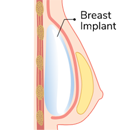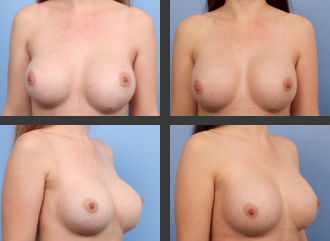What is Breast Augmentation?
Breast augmentation or mammaplasty involves the placement of an implant behind the breast. This will increase breast size, upper pole fullness, and create cleavage and breast outline. Breast implants will also fill out and lift the breast to a certain degree.
Women undergo a boob job for several reasons, such as volume loss after breastfeeding or weight loss, which may have significantly altered breast shape and size. In some cases, women who have had a mastectomy may want a breast augmentation as the first step of breast reconstruction.
When you see Dr Broadhurst, you will be treated in confidentiality and comfort. Your procedure will be performed to the highest surgical standards for a smooth, comfortable, and positive experience.
Breast Augmentation with Dr Broadhurst
“I pride myself on the individual care and support I provide each of my patients. From your first consultation, I will work one-on-one with you to tailor a treatment plan to suit your body.”

Types of Breast Implants
The type and size of the implants you choose will depend on what size you want your breasts to be, your skin thickness and elasticity, your breast anatomy, and your body type. Dr Broadhurst will work with you to determine which choice is right for you, as there are many factors to consider.
The types of breast implants used for breast augmentation surgery include:
Silicone Implants
Silicone implants are made of a cohesive, elastic gel designed to mimic the look and feel of natural breast tissue. Even if your implants rupture or leak, the gel will stay together, reducing the potential for risks such as silicone migration and extracapsular spread.
Saline Implants
Saline implants contain a certain amount of sterilised saltwater surrounded by an outer silicone layer. This implant has a different feel, shape, and firmness than silicone implants. In the event of a saline implant leaking, it will collapse, and the body will naturally absorb the saline.
You will need to decide on the shape of the breast implants. Both implant types are available in the following forms:
Round Breast Implant

Round breast implants are the most common breast implant shape. There are four different types of projection with round implants, which can influence the volume, upper pole fullness, cleavage, and overall shape. Round implants create more fullness at the top of the breasts and are suitable if you want to correct sagging for a fuller appearance.
Teardrop Breast Implant

Teardrop breast implants provide a more natural breast appearance, making the bottom of the breasts fuller rather than the top. Breast volume and fullness is not lost; instead, it is concentrated around the bottom portion of the breast. This is an excellent option for women who prefer a very natural look.
This all may seem overwhelming, but Dr Broadhurst will indicate what choices are best for you based on your body anatomy. There is no wrong choice, as it is all about your individual needs and preferences, and all options have their pros and cons. It is about deciding which options suit you the best, comparing the positives and negatives for the most optimal result.
Consultation
What to expect during your consultation?
Dr Broadhurst’s focus is two-fold: to ensure that you are happy with your breast enlargement procedure and to leave with a finished result that is proportional, natural-looking, and symmetrical. He will consult with you in detail about your breasts’ shape, size, and style and work closely with you to ensure that you make the right choice concerning your breast implants.
Your initial consultation is a virtual appointment via FaceTime.
Dr Broadhurst will ask you questions about your medical history. You will discuss your treatment plan in detail and begin making decisions about your breast enlargement.
In consultation with him, essential decisions will be made about implant type and size, incision placement, and implant shape. You will also discuss what the procedure entails and what you can expect after surgery and during your recovery.
Your Second Consultation
You will see Dr Broadhurst for a second consultation, face to face, at our Brisbane, Sunshine Coast, Hervey Bay, or Bundaberg locations, and can be had at the location closest to you. This appointment will be scheduled to ensure you completely understand your procedure and express any concerns or anxieties that you may be experiencing. You are eligible to book your surgery date 7 days after your second consultation if you are a suitable candidate for surgery.
With 18+ years of experience, Dr Andrew Broadhurst has heard almost every patient question or concern. You can feel confident he will provide you with well-informed answers about breast surgery for your peace of mind.
Procedure
What to expect during your procedure?
Breast augmentation is performed as day surgery under a general anaesthetic. The surgery roughly takes one hour to complete unless you combine your breast augmentation with other procedures such as an abdominoplasty.
Dr Broadhurst carefully measures and marks the implant ‘pocket’. An incision is made through the skin and down to the site where the implant is placed. He will create a dual plane pocket under and over your breast muscle to fit the implant. An internal bra is also used to support your implant and ensure it stays exactly where it is placed. Accurate implant pocket creation, precise implant placement, and attention to detail are critical to a successful surgery. Once the implant is inserted, the incision will be closed with internal dissolving sutures.
Breast Implant Placement
Sub-glandular Placement

Sub-glandular or ‘over the muscle’ is when the breast implant is placed above the pectoralis muscles but underneath the breast tissue. Placing the implant in front of the muscle is the simplest option. Still, in women with small breasts and those who are very thin, the implant’s upper border can be visible due to insufficient tissue overlying it.
Sub-muscular Placement

Submuscular or ‘under the muscle’ is when the breast implant is placed under the pectoralis muscle. Placement of the implant under the muscle allows for more breast tissue coverage helping to camouflage the implant providing a more natural appearance. Placement of the implant under the muscle also reduces the rate of capsular contracture (a firm scar that can form around the implant).
Dual Plane Placement

Dual plane placement is a combination of both over and under the muscle. It can provide the best of both worlds by camouflaging the upper part of the implant whilst allowing for a full-looking lower ‘pole’. This type of placement will often create the most natural, aesthetically pleasing breasts, so Dr Andrew Broadhurst most commonly uses this placement.
Incisions & Scarring
An incision in the skin is required to insert an implant. The three most common types of incisions are infra-mammary (in the fold underneath your breasts), peri-areolar (semi-circle around the lower part of your nipple) and axillary (in the armpit). Dr Broadhurst performs a 4-6cm incision at the infra-mammary fold as scarring is concealed, gives excellent surgical access during the procedure, and allows a new fold to be made.
Depending on the extent of physical activity you undertake, you should fully recover within one to two weeks.


